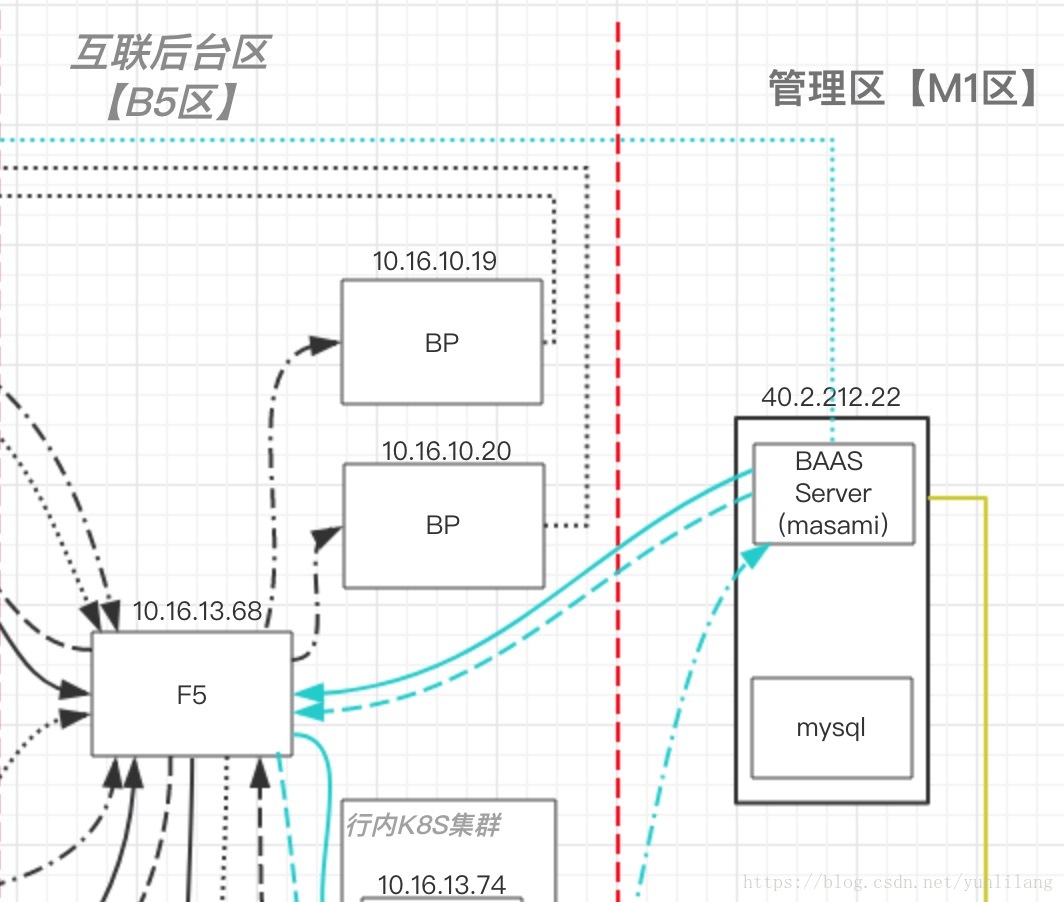#背景
-
在做区块链项目时,银行发送业务交易时有时会出现超时,报错的response;于是跟踪部署的服务的相关容器,发现业务chaincode容器存在不断重启的现象,业务chaincode容器存活一般几分钟到几小时不等。这说明chaincode容器异常挂掉过,然后再被拉起。
-
但是获取区块链状态的状态chaincode没有重启过,一直在运行。
#现象描述
具体地,chaincode容器的日志如下:

错误为:
[E] [chaincode.go:304] Received error from server: [rpc error: code = Internal desc = transport is closing], ending chaincode stream
相应地,peer上的错误日志如下:

错误为:
2018/07/11 08:11:11 [E] [handler.go:329] Error handling chaincode support stream: [rpc error: code = Canceled desc = context canceled]
从以上现象,可知chaincode确实因为错误挂掉了,这个错误表面上看是因为一个rpc error导致的,再具体一点的原因是:transport is closing, 也即是因为rpc的这个链接被关掉了,但是为何被关掉现在还不得知。
#原因分析
原因分析一:查看代码,追溯何因导致
chaincode启动过程:
main()->shim.Start()->userChaincodeStreamGetter():主要是创建grpc的连接,返回stream对象-> chatWithPeer(chaincodename, stream, cc):与peer建立通信,处理一些消息
###grpc client端:chaincode处理peer发过来消息方法:
go func() {
...
for {
in = nil
err = nil
nsInfo = nil
if recv {
recv = false
go func() {
var in2 *pb.ChaincodeMessage
in2, err = stream.Recv()
msgAvail <- in2
}()
}
select {
case sendErr := <-errc:
//serialSendAsync successful?
if sendErr == nil {
continue
}
//no, bail
err = fmt.Errorf("Error sending %s: %s", in.Type.String(), sendErr)
return
case in = <-msgAvail:
if err == io.EOF {
chaincodeLogger.Debugf("Received EOF, ending chaincode stream, %s", err)
return
} else if err != nil {
chaincodeLogger.Errorf("Received error from server: %s, ending chaincode stream", err)
return
} else if in == nil {
err = fmt.Errorf("Received nil message, ending chaincode stream")
chaincodeLogger.Debug("Received nil message, ending chaincode stream")
return
}
chaincodeLogger.Debugf("[%s]Received message %s from shim", shorttxid(in.Txid), in.Type.String())
recv = true
case nsInfo = <-handler.nextState:
in = nsInfo.msg
if in == nil {
panic("nil msg")
}
chaincodeLogger.Debugf("[%s]Move state message %s", shorttxid(in.Txid), in.Type.String())
}
// Call FSM.handleMessage()
err = handler.handleMessage(in)
if err != nil {
err = fmt.Errorf("Error handling message: %s", err)
return
}
//keepalive messages are PONGs to the fabric's PINGs
if in.Type == pb.ChaincodeMessage_KEEPALIVE {
chaincodeLogger.Debug("Sending KEEPALIVE response")
//ignore any errors, maybe next KEEPALIVE will work
handler.serialSendAsync(in, nil)
} else if nsInfo != nil && nsInfo.sendToCC {
chaincodeLogger.Debugf("[%s]send state message %s", shorttxid(in.Txid), in.Type.String())
handler.serialSendAsync(in, errc)
}
}
}()
...
从代码上可知因为:
case in = <-msgAvail:
if err == io.EOF {
chaincodeLogger.Debugf("Received EOF, ending chaincode stream, %s", err)
return
} else if err != nil {
chaincodeLogger.Errorf("Received error from server: %s, ending chaincode stream", err)
return
}
stream.Recv()时出现了错误,这个错误是:transport is closing.
###grpc server端:peer的相关处理方法:
1.chaincode通过gprc调用register方法:
// Register the bidi stream entry point called by chaincode to register with the Peer.
func (chaincodeSupport *ChaincodeSupport) Register(stream pb.ChaincodeSupport_RegisterServer) error {
return chaincodeSupport.HandleChaincodeStream(stream.Context(), stream)
}
2.HandleChaincodeStream
// HandleChaincodeStream Main loop for handling the associated Chaincode stream
func HandleChaincodeStream(chaincodeSupport *ChaincodeSupport, ctxt context.Context, stream ccintf.ChaincodeStream) error {
deadline, ok := ctxt.Deadline()
chaincodeLogger.Debugf("Current context deadline = %s, ok = %v", deadline, ok)
handler := newChaincodeSupportHandler(chaincodeSupport, stream)
return handler.processStream()
}
3.处理chaincode发过的消息:
processStream(){
...
for {
...
select {
case in = <-msgAvail:
// Defer the deregistering of the this handler.
if err == io.EOF {
chaincodeLogger.Debugf("Received EOF, ending chaincode support stream, %s", err)
return err
} else if err != nil {
chaincodeLogger.Errorf("Error handling chaincode support stream: %s", err)
return err
} else if in == nil {
err = fmt.Errorf("Received nil message, ending chaincode support stream")
chaincodeLogger.Debug("Received nil message, ending chaincode support stream")
return err
}
}
...
}
通过peer日志和代码可知grpc server端也出现错误:chaincodeLogger.Errorf(“Error handling chaincode support stream: %s”, err),这个错误具体地为:contexted canceled. 一般地,导致此错误的原因是对方的线程关掉了。
##原因分析二:
-
通过以上日志和代码初步怀疑:grpc连接出现问题,导致chaincode容器退出,server端接收到context canceled的错误。
-
检查chaincode和peer之前的网络连接情况。
由于区块链项目部署在各家银行内部,银行内部网络关系比较复杂,具体地一般访问需要开通网络端口,经过F5:

-
抓业务chaicode:7052映射为(32007) 与peer之间的通信的报文:
1、所有通信端口交互的情况:

2、业务chaincode与peer通信的报文情况:

-
从以上抓包可知在发生业务chaincode挂掉的时间段里,chaincode与peer没有抓到报文,也即是没有通信。
-
从银行运维了解到我们申请的端口访问关系都是短链接,f5规定所有短链接,如果超过300秒没有数据通信,会进行拆链操作,也就是把此链接断掉
这也就解释了为什么会出现grpc connetion err: transport is closing的错误,在300秒内没有业务的话,这条链接会被f5断掉,导致业务的chaincode挂掉。
#解决方案
grpc在创建连接时有一个keepalive的配置选项,也就是server端会给这个链接发送keepalive message:
case <-handler.waitForKeepaliveTimer():
if handler.chaincodeSupport.keepalive <= 0 {
chaincodeLogger.Errorf("Invalid select: keepalive not on (keepalive=%d)", handler.chaincodeSupport.keepalive)
continue
}
//if no error message from serialSend, KEEPALIVE happy, and don't care about error
//(maybe it'll work later)
handler.serialSendAsync(&pb.ChaincodeMessage{Type: pb.ChaincodeMessage_KEEPALIVE}, nil)
continue
如果keepalive选项打开就会定时发送keepalive消息,这样f5就不再会进行拆链,因此grpc链接可以保持。
综上,解决方案为:打开keepalive选项
# keepalive in seconds. In situations where the communiction goes through a
# proxy that does not support keep-alive, this parameter will maintain connection
# between peer and chaincode.
# A value <= 0 turns keepalive off
keepalive: 30s
经过验证,业务容器不在频繁挂掉。
#总结
至此,排查出业务chaincode频繁重启的原因,但是还有一个问题我们的状态chaincode为什么没有频繁挂掉重启呢?网络关系也是一样的,keepalive同样没有开启。
这是因为我们状态chaincode每30秒会有一个获取区块状态的交易,这样的话f5就不会对这个链接进行拆链操作,所以不会出现chaincode挂掉的情况。
最后一点,在跨网进行服务部署的时候,一定要弄清楚网络访问的关系和特性,不然会耗费很大的人力和物力去排查解决,特别是已经上线的系统。







 区块链项目中,业务chaincode容器频繁重启,日志显示为`transport is closing`错误。分析发现,原因是银行内部网络环境中,F5在300秒无数据通信时会断开连接。解决方案是启用grpc的keepalive选项,保持连接活跃,避免容器重启。状态chaincode因每30秒有交易,避免了类似问题。
区块链项目中,业务chaincode容器频繁重启,日志显示为`transport is closing`错误。分析发现,原因是银行内部网络环境中,F5在300秒无数据通信时会断开连接。解决方案是启用grpc的keepalive选项,保持连接活跃,避免容器重启。状态chaincode因每30秒有交易,避免了类似问题。
















 1204
1204

 被折叠的 条评论
为什么被折叠?
被折叠的 条评论
为什么被折叠?








